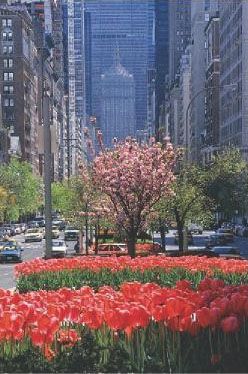 |
From Garden Guide: New York City, 2010 (Revised Edition)
By Nancy Berner and Susan Lowry
Publishers: W.W.Norton
Photograph by Joseph De Sciose
[Discussed on pp. 96-97]
During my last visit in New York, I bought a few guides (including a Micheline Guide) to visit some off-the-beaten-track (for me at least) places in the city.
At the Barnes and Nobles in Grand Central Terminal, I found a lovely, small book (it is smaller than a pocket book, but has a sturdy hard back cover) called Garden Guide: New York City by Nancy Berner and Susan Lowry.
This is a lovely book to read, well-written and well-researched, where we can get a little of spring and summer during these winter months when gardens are dormant. Also, it is a respite from the depressing and downright frightening current events around the world.
About the authors, the back of the guide says this:
Nancy Berner and Susan Lowry lecture widely about New York City's gardens and are the authors of Gardens of the Hudson Valley. They both live in New York City and are longtime volunteers at Central Park's Conservatory Garden.Their website has more on their backgrounds:
Nancy Berner has worked as a book editor and an editorial consultant to several non-profits. Susan Lowry was a television journalist in Canada and the United States before switching fields and earning a diploma in landscape architecture.And the publisher has this to say (more here):
Both Susan and Nancy live in New York City, where they are longtime volunteers at the Conservatory Garden in Central Park. Together, Susan and Nancy have lectured widely in New York, New Jersey, and Connecticut on the subject of urban public gardens.
Tucked inside venerable museums, perched on rooftops, concealed behind sleek midtown facades, and waiting beyond unassuming gates you may have passed a hundred times, if you know where to look, remarkable gardens welcome visitors in almost every corner of New York City.The book is divided into the various sections of New York, with each section listing a selection of gardens:
Manhattan:Then Bronx, Brooklyn, Queens and Staten Island are listed separately (without sub-divisions).
Upper Manhattan
Upper West Side
Upper East Side
Midtown
Downtown
The garden designers (many of them women) are also discussed in the sections.
Wherever there is a historic building associated with a garden the architects of the building (all of them men) are also discussed.
And there are some surprising gems, like the hidden gardens in the Frick Museum, or the Cooper Hewitt National Design Museum Gardens (unfortunately closed for renovation until 2014).
I have one qualm with the book: There aren't enough photos.
But then, good descriptive writing should evoke images and imagery. On reading about these places and gardens, I am curious (and intrigued) to go and visit them, and if not, to do some other searches on the web, and other books, to find out more.
Although gardens are supposedly for those warmer months of spring and summer, there are parks and gardens which do cultivate winter plants, and there are a couple of conservatories which fill their interiors with all kinds of plants all year round, such as the Steinhardt Conservatory at the Brooklyn Botanic Garden, and the Enid A. Haupt Conservatory at the New York Botanical Garden in the Bronx.
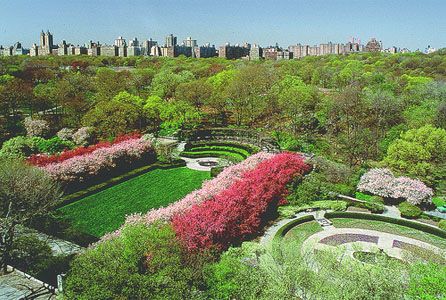 |
[Discussed in:
Garden Guide: New York City pp. 80-86]
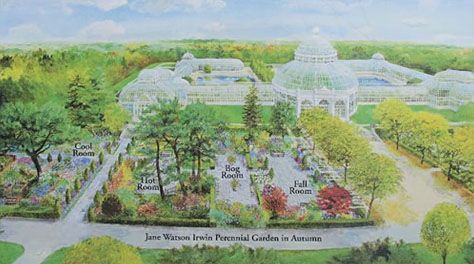 |
[Discussed in:
Garden Guide: New York City pp. 252-265]
 |
[Discussed in:
Garden Guide: New York City pp. 33-37]
Cloisters Flowers
Photo by KPA
According the the Garden Guide, the Cloister Gardens were divided into three sections:
- The Cuxa Cloister Garth Garden, which
was assembled from the remnants of a Romanesque (eleventh century) Benedictine monastery, Saint-Michel-de-Cuxa, located in the French Pyrenees...- The Bonnefont Cloister Herb Garden
This space demonstrated key elements of the medieval garden: it is enclosed, rigorously symmetrical, and organized around a central feature, here a handsome fountain.
On the lower level of the museum is the Bonnefont Cloister, a tidy working herb garden that, except for the stunning views of the George Washington Bridge in the distance, looks like a page from a medieval script.- The Trie Cloister Garden,
...named for the Carmelite convent in Trie-en-Bigorre in south-western France, the original site for much of the stonework.
 |
[Discussed in: Garden Guide: New York City pp. 33-37]
Periwinkle Label:
"Common Periwinkle, Myrtle
Vinca minor
Photo by KPA
The information plaque by the periwinkle bed described the flower as a medieval cancer treatment.
Annual periwinkles have been used for centuries for folk medicine, especially for treating diabetes, and are the source of several cancer drugs.And from this site, on the meaning of the flower's name:
The Latin name of periwinkle's genus, Vinca, is derived from a word meaning "to overcome."Such a small flower, with such a sturdy name!
Below is a single flower, standing its ground. Although the flower bed nearby is full of periwinkles, this one flower stood out amidst a hostile leaves.
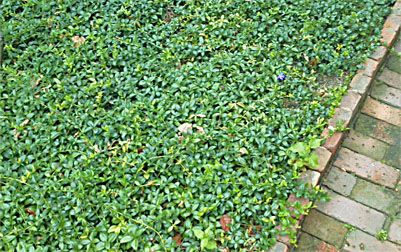 |
[Discussed in: Garden Guide: New York City pp. 33-37]
Periwinkle Label:
"Common Periwinkle, Myrtle
Vinca minor
Photo by KPA
And below is the bronze statue "Memory" in Straus Park on Broadway and 107th, about which I have written here.
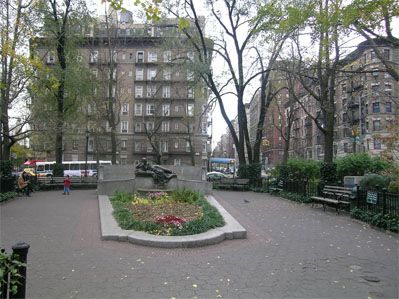 |
in Straus Park was sculpted by Augustus Lukeman
and dedicated on April 15, 1915.
[Discussed in: Garden Guide: New York City pp. 252-265]